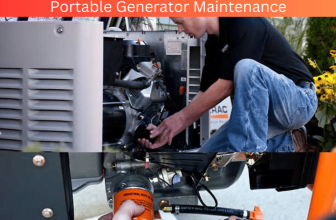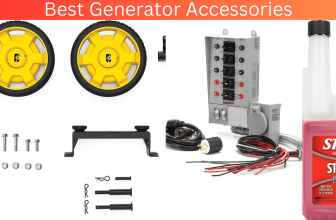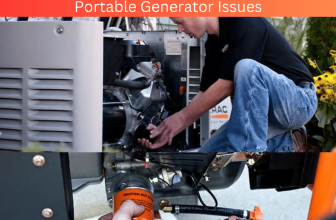
Hey there, do-it-yourselfers! If you’re considering owning a portable generator, you’re probably wondering how to care for it and keep it running in top condition. Don’t worry – I’m here to give you a beginner’s guide to portable generator maintenance and care.
In this article, we’ll cover all the basics of portable generator ownership and upkeep, so you can have peace of mind knowing your generator is well taken care of. We’ll go over the different types of portable generators available and their maintenance needs.
We’ll also look at common problems with generators and how to go about fixing them. With a few easy steps, you’ll be well on your way to becoming an expert in portable generator maintenance and care in no time!

Types Of Portable Generators
When it comes to power outages, having a portable generator is essential. It’s the perfect solution for keeping your essential appliances running when you lose power.
Not sure what kind of generator you need? No problem; there are several types of portable generators that can fit your needs.
Portable generators come in three types: gas-powered, diesel-powered, and propane-powered. Gas-powered generators are the most common type and come at affordable prices. They typically range from 1,000 to 10,000 watts and have an average run time of 7 to 12 hours on a gas tank.
Diesel-powered generators have higher running costs but are more fuel efficient and have longer run times than gas-powered ones. Propane-powered generators are also available but are more expensive than other models.
To make sure you get the right generator for your needs, consider the wattage output that you need as well as any safety features you may want, such as low oil shut off or digital control panel displays. It would be best if you also thoughtconsideroften you plan on using it and how much noise it will make while in use.
Knowing these factors can help ensure that you get a reliable generator that meets all your needs. Now let’s move onto discussing generator maintenance basics!
Generator Maintenance Basics
Hey there! You’re about to learn the basics of generator maintenance and care. Taking proper care of your generator is essential for ensuring it works when you need it and doesn’t break down on you. We’ll start with some simple steps that will help you keep your generator up and running.
First, let’s talk about checking the engine oil level. This is a critical step in keeping your generator in top condition. It’s important to check the oil level regularly, especially after long periods of use or if the engine has been running for a while. That way, you can be confident that your generator has enough lubrication to keep running smoothly.
Next, we’ll discuss changing the oil filter and spark plug. These components are key pieces in keeping the engine clean and free from debris that can cause damage or reduce its performance over time. Replacing them regularly will ensure that dirt and other particles don’t accumulate and potentially affect the operation of your generator.
Now that we’ve gone over some basics of maintenance and care let’s move on to inspecting and replacing the oil—the lifeblood of any engine!
Checking And Replacing The Oil
Taking care of your portable generator is easy and important. I will walk you through checking and replacing the oil, which is one of the most critical steps in the maintenance process. Let’s get started!
The best way to check the oil level in your generator is by using a dipstick. Start by pulling out the dipstick, wiping it clean with a rag, and reinserting it into the engine. Once you pull it out again, check where the oil line is on the stick—it should be between two marks. If it isn’t, you’ll need to add more oil until it reaches that optimal level.
Next, you’ll want to replace the oil if its been a few months or if its been contaminated with dirt or water. To do this, pour out all of the old oil using an oil pan and then fill up with new oil that meets your generator’s specifications. After that, just make sure all of the connections are tightened before running your generator again.
Now that you know how to check and replace your generator’s oil, let’s move onto cleaning and replacing its air filter—a task that can help keep your engine running optimally for years to come.
Cleaning And Replacing The Air Filter
Cleaning and replacing the air filter on your portable generator is an essential part of keeping it running in optimal condition. The air filter protects the engine from dirt, dust and debris that can cause significant damage over time. It’s important to check your air filter regularly and replace it once a year or when necessary.
To clean or replace your air filter, first you need to locate it. On most generators, the air filter will be located near the carburetor or close to the right side of the engine. Once you have found it, you can begin either cleaning or replacing it, depending on its condition.
To clean it, use a soft brush and vacuum to remove any dirt or debris build up before reinstalling it back into place. If the filter is severely clogged with dirt and debris, you may want to consider replacing it altogether for better engine performance.
When reattaching the new filter, make sure that all connections are securely fastened before turning on your generator again. This will help prevent any dust from entering the engine and causing further damage down the line.
After ensuring that everything is in order, move onto inspecting the ignition system for proper maintenance of your portable generator.
Inspecting The Ignition System
Now it’s time to take a look at the generator’s ignition system. This is a critical component of any generator since it’s responsible for starting up the engine. Without properly functioning ignition components, your generator will bdiein the water.
The first step is to check that all spark plugs are connected and working properly. Make sure they are not corroded or dirty, as this can affect their ability to conduct electricity between the different electrical components. Inspect each spark plug wire for signs of wear or damage and replace them if necessary. You should also check that the spark plug gap is set correctly by referring to your owner’s manual or consulting with a professional technician.
Next, inspect the magneto and flywheel assembly to ensure that everything is securely attached and in good working order. Make sure there are no loose screws or exposed wires that could cause an electrical hazard. If you find any issues with these components, it may be best to have them professionally serviced before proceeding further with maintenance on your generator.
With a thorough inspection complete, you’re now ready to move on to checking the fuel system.
Checking The Fuel System
Taking care of your portable generator’s fuel system is essential for keeping it running. I recommend checking the fuel system every month or so, or before ach time you use it.
Start by checking the fuel lines and filter to ensure they are in good condition and there are no signs of leakage. If you’re unsure about how to do this, refer to your operator’s manual for more information.
Inspect the fuel cap for any damage or warping, and make sure it seals properly when closed. It’s also a good idea to check the oil level in the engine – if this is too low, top it off with fresh oil specifically designed for your generator.
Next, you’ll want to test the fuel itself. If you’ve had the same tank of gas sitting around for a while, chances are it won’t be usable anymore and will need to be drained out and replaced with fresh fuel.
To find out if your fuel is still good, pour a bit of it into a clear container and observe its color; if it has turned dark or murky, then that’s an indication that it needs replacing. You should also give the container a sniff; if there’s a strong odor coming from the gas then discard it immediately – bad gas can cause serious damage to your generator!
Now that we’ve gone over the basics of checking your generator’s fuel system, let’s take a look at testing its alternator.
Testing The Alternator
Testing the alternator is a crucial step in portable generator maintenance and care. It’s important to ensure that the device is producing enough electricity to power whatever you need it for. To test the alternator, you’ll need to use a multimeter. Here’s how to do it:
| Step | Description | Tools Required |
|---|---|---|
| 1 | Set your multimeter to “DC volts” and make sure the black lead is in the negative slot, while the red lead is in the positive slot. | Multimeter & Battery Cables |
| 2 | Start your generator and check voltage at both battery terminals with your multimeter. Make sure it reads between 13.2 and 14.4 volts (for 12V units). If not, then you may have a bad alternator or other component issue. | Multimeter & Wrench Set |
| 3 | Disconnect both battery cables from their respective connections on the generator frame and check voltage again on both terminals with your multimeter. This should read 0 volts if there are no other electrical loads present on the machine. If not, then there may be an issue with the wiring or another component within the generator system causing it to draw current even when disconnected from its power source(s). | Multimeter & Screwdriver Set |
With these steps, you can easily test your alternator and identify any potential issues before they become larger problems down the line. Knowing how to troubleshoot common generator problems will help keep yours running smoothly for years to come!
Troubleshooting Common Generator Problems
Now that you’ve tested the alternator, it’s time to move on to troubleshooting any common generator problems.
The first thing to check is the fuel and oil levels. If they’re low, top them up and see if that solves the issue.
You should also make sure your generator is getting enough air flow so it can run properly. Look for any obstructions or blockages, like leaves or other debris.
Next, inspect the spark plugs and wires for any signs of damage or corrosion. If they look worn or damaged, replace them before continuing with troubleshooting. If you don’t feel comfortable doing this yourself, take your generator to a certified technician who can help.
Finally, check the battery connections and terminals for any loose wiring or corrosion build-up. Clean off any rust as needed and tighten up any loose connections before moving on to storing your generator properly.
Storing your generator correctly will ensure it’s ready when you need it most!
Storing Your Generator Properly
Storing your generator properly is an important step in keeping it in top shape and ensuring it will last a long time. It’s essential to create the right environment for your generator so that it doesn’t corrode or become damaged by extreme temperatures, dust, or other debris.
Here’s what you need to keep in mind:
| Condition | Do | Don’t |
|---|---|---|
| Humidity | Store in dry areas with adequate ventilation | Store near water sources such as pools, lakes, etc. |
| Temperature | Keep out of direct sunlight and store between 40-90 degrees Fahrenheit | Leave outside exposed to extreme temperatures |
| Cleanliness | Clean regularly with a damp cloth and make sure the vents are not blocked by dust or debris | Allow dirt, dust, and other materials to accumulate on the generator |
When storing your generator, you should also cover it up with a tarp or other protective material. This will help prevent rusting, fading from UV rays, and dirt buildup. Make sure you give your generator some breathing room when covering it up – don’t put it too tightly! Taking these steps will ensure that your generator stays in perfect condition for many years to come.
No matter how well you maintain your generator there may be times when you need professional assistance. In those cases, be sure to find a knowledgeable technician who is experienced with generators like yours.
Getting Professional Assistance When Necessary
Storing your generator properly is an important part of keeping it running smoothly and safely. Now that you’ve taken the necessary steps to ensure your generator is well-looked after, you may still need some help from the professionals.
Getting professional assistance for your portable generator can be helpful for a variety of reasons. If you run into any issues with your generator, it’s always best to get in touch with an expert who can provide insight into what might be causing them. Even if the issue seems minor, getting professional help can save time and money in the long run by preventing further damage or expensive repairs.
In addition to repair services, experts are also beneficial if you need advice on how to use your generator properly or want assistance with routine maintenance. They can answer any questions you may have about proper operation and give guidance on how to keep your generator in good condition over its lifetime.
With their expertise, they can make sure that you get the most out of your portable generator.
Frequently Asked Questions
What Type Of Portable Generator Is Best For My Needs?
Are you in the market for a portable generator but not sure what type is best for your needs?
Whether you’re looking for a generator that can power a few appliances or an entire house, there are plenty of options out there to choose from.
Consider how much wattage you need, if any additional features like remote start and portability matter to you, and your budget when making your selection.
Make sure to do your research so you can find the best generator for your specific needs.
How Often Should I Perform Maintenance On My Portable Generator?
Maintaining your portable generator is essential for keeping it running safely and efficiently. It’s important to perform regular maintenance on your generator, as neglecting to do so can lead to costly repairs or even a complete breakdown.
Depending on the type of generator you have, you should aim to perform maintenance at least once every three months or after every 50 hours of use. This includes checking oil levels, cleaning air filters, and testing the battery charge. Additionally, make sure to inspect all hoses and connections that could be prone to wear and tear.
Taking care of your portable generator will not only keep it running smoothly but also help ensure its longevity.
What Type Of Oil Should I Use In My Portable Generator?
When it comes to maintenance on your portable generator, the type of oil you use is important.
It’s best to use an engine oil that meets or exceeds the manufacturer’s recommended viscosity grade for your particular model.
If you’re unsure what type of oil to use, consult your owner’s manual or contact the manufacturer directly for more information.
You can also refer to your local auto parts store for advice.
How Can I Tell When To Replace The Air Filter?
When it comes to your portable generator, the air filter should be regularly checked and replaced when necessary.
To determine when it needs replacing, start by checking for any buildup of dirt or debris on the filter itself.
If you notice it’s looking especially dirty or clogged, it’s time to replace it with a new one.
Additionally, if you experience sudden changes in power output from your generator, this could also be an indication that the air filter needs replacing.
In any case, if in doubt, always consult your manufacturer’s guidelines for more specific information on how often to change the air filter.
What Kind Of Safety Precautions Should I Take When Using My Portable Generator?
When it comes to using your portable generator, safety should be your top priority. You always want to make sure you’re taking precautions when operating it, such as not running it indoors and keeping it away from any flammable materials.
You also need to keep an eye on the exhaust fumes, making sure they’re not building up in any enclosed areas. When refueling, turn off the power and let the engine cool down.
Finally, always wear protective gear like gloves and goggles when working with your generator. Taking these simple steps is essential for staying safe when using your portable generator!
Conclusion
It’s essential to have a good understanding of portable generator maintenance and care in order to ensure that your generator is working efficiently and safely.
Taking the time to research what type of portable generator best suits your needs, performing regular maintenance, using the correct oil, replacing the air filter as needed, and taking necessary safety precautions will help you get the most out of your generator for years to come.
With a little bit of knowledge and effort, you’ll be able to enjoy the convenience of having a portable generator without worrying about any potential problems.





